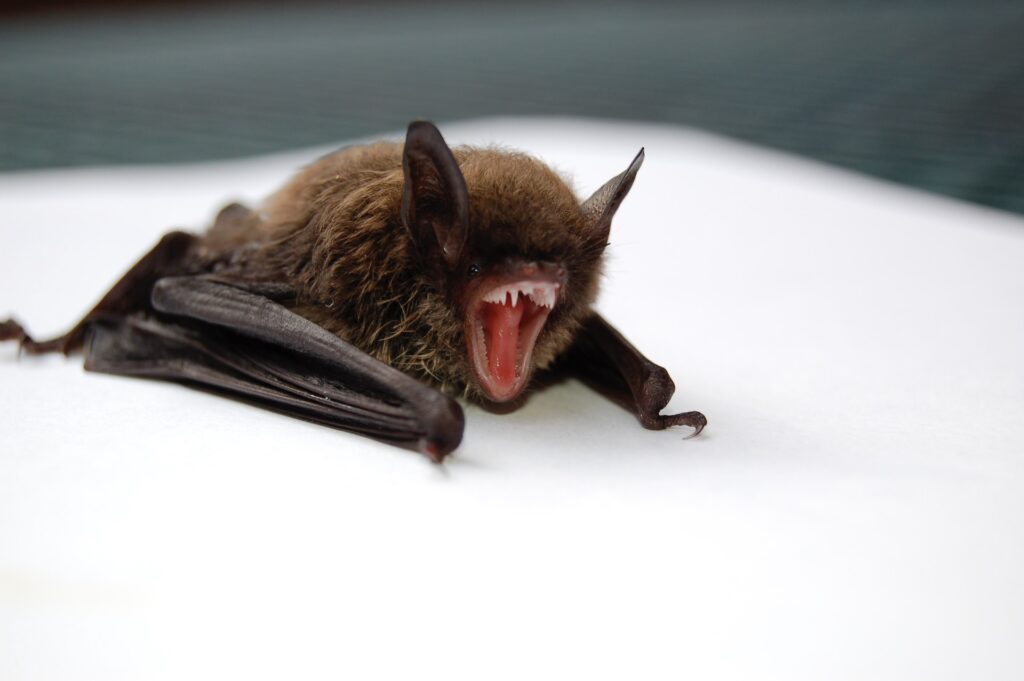How to Get Rid of Bats: Tips and Tricks for Safe Removal

Bats are an essential part of our ecosystem, but they can cause trouble when they decide to roost in our homes or buildings. If you find yourself dealing with a bat infestation, it’s important to address the problem quickly and safely. In this article, we’ll discuss effective methods for getting rid of bats and preventing them from returning.
One of the best ways to get rid of bats is to use exclusion devices. These devices allow bats to leave their roosting spot, but prevent them from returning. By installing exclusion devices like one-way valves or tubes, you can create a safe and humane way to remove bats from your home or building. It’s important to note that exclusion devices should only be installed by a professional, as improper installation can harm the bats or cause them to become trapped inside.
Another effective method for getting rid of bats is to use natural deterrents. Bats are sensitive to certain smells and tastes, so using repellents like peppermint oil or garlic can help keep them away. Additionally, you can install bat houses outside of your home or building to provide a safe and attractive alternative roosting spot. By using a combination of exclusion devices and natural deterrents, you can safely and effectively get rid of bats and prevent them from returning.
Understanding Bat Behavior
Bats are nocturnal creatures that are known for their ability to fly and their unique echolocation system. While they are beneficial to the ecosystem because they feed on insects, they can become a nuisance when they enter homes. In order to effectively get rid of bats, it is important to understand their behavior.
Reasons Bats Enter Homes
Bats are attracted to homes for a variety of reasons. One of the most common reasons is for shelter. Bats will often seek out warm, dark, and dry places to roost during the day. This can include attics, chimneys, and crawl spaces. Additionally, bats may enter homes in search of food. If there are insects inside the home, bats may follow them inside.
Bat Species Commonly Found in Homes
There are several bat species that are commonly found in homes. The most common species is the little brown bat. These bats are small, brown, and have a wingspan of about 8-9 inches. They are known for their ability to squeeze through small openings and are often found in attics and crawl spaces.
Another species that is commonly found in homes is the big brown bat. These bats are larger than the little brown bat and have a wingspan of about 12-13 inches. They are also known for their ability to squeeze through small openings and are often found in attics and chimneys.
It is important to note that bats are protected by law in many areas. It is illegal to harm or kill bats without a permit. If you are experiencing a bat infestation, it is best to contact a professional wildlife removal service to safely and legally remove the bats from your home.
Preventive Measures
Bats are known to be beneficial creatures, but they can become a nuisance when they take up residence in your home. To prevent bats from entering your home, it is essential to take preventive measures. Here are some effective preventive measures that you can take to keep bats at bay.
Home Sealing and Repairs
The first step to keeping bats out of your home is to seal any gaps or openings that may serve as entry points. Bats can enter through very small openings, so it is essential to inspect your home thoroughly. Check for gaps around windows, doors, and vents, and seal them with caulk or weather stripping. Repair any damaged screens or vents, and replace missing or damaged roof tiles.
Natural Bat Repellents
If you want to keep bats away from your home without harming them, you can use natural bat repellents. Some plants, such as eucalyptus and peppermint, are known to repel bats. You can plant these around your home to keep bats away. You can also use essential oils, such as peppermint or cinnamon, to create a spray that you can use around your home.
Landscape Management
Your landscape can also play a role in keeping bats away from your home. Bats are attracted to insects, so it is essential to keep your yard free of standing water and debris, as these can attract insects. You can also plant insect-repelling plants, such as lavender or marigolds, to keep insects away. Additionally, keeping your lawn mowed and trimmed can help to reduce the number of insects in your yard.
By taking these preventive measures, you can keep bats from entering your home and causing damage. However, if you already have a bat infestation, it is essential to call a professional to handle the situation.
Bat Removal Techniques
Bats are beneficial for the environment, but when they invade human dwellings, they become a nuisance. Here are some effective bat removal techniques:
Professional Bat Removal Services
Professional bat removal services are the safest and most effective way to get rid of bats. These services have trained professionals who use humane techniques to remove bats. They also have the necessary equipment to remove bats safely. Some of the techniques used by professional bat removal services include:
- Live exclusion
- One-way doors
- Netting
- Bat cones
- Fumigation
Professional bat removal services also provide cleanup and repair services. They remove bat droppings, disinfect the area, and repair any damage caused by the bats.
Exclusion Devices and Methods
Exclusion devices and methods are also effective in removing bats from human dwellings. These devices and methods prevent bats from entering the building while allowing them to exit. Some of the exclusion devices and methods include:
- Bat cones
- One-way doors
- Netting
- Sealing entry points
One-way doors and bat cones are placed over entry points, allowing bats to exit but not re-enter. Netting is used to cover larger areas, preventing bats from entering. Sealing entry points involves identifying and sealing any gaps or cracks in the building that bats can use to enter.
It is important to note that exclusion devices and methods should only be used after ensuring that there are no bats left in the building. This can be done by observing the building at dusk, when bats leave to feed.
Post-Removal Considerations
After successfully removing bats from a property, there are a few post-removal considerations that homeowners should keep in mind. These considerations include cleaning and sanitization, as well as monitoring and maintenance.
Cleaning and Sanitization
Cleaning and sanitization are important steps to take after removing bats from a property. Bat droppings, also known as guano, can carry harmful pathogens that can cause respiratory problems in humans. Therefore, it is important to wear protective gear, such as gloves and a mask, when cleaning up bat droppings.
To properly clean and sanitize an area affected by bat droppings, homeowners should follow these steps:
- Remove any visible droppings and dispose of them in sealed plastic bags.
- Use a HEPA vacuum to clean up any remaining droppings and debris.
- Use a disinfectant to sanitize the affected area, following the manufacturer’s instructions.
- Allow the area to dry completely before using it again.
Monitoring and Maintenance
After removing bats from a property, it is important to monitor the area to ensure that they do not return. Homeowners should inspect their property regularly for signs of bat activity, such as droppings or urine stains.
In addition to monitoring, homeowners should also take steps to prevent bats from re-entering their property. This can include sealing any entry points that bats may use, such as gaps in roof tiles or vents. Homeowners can also install bat boxes in nearby trees to provide bats with an alternative roosting location.
By following these post-removal considerations, homeowners can ensure that their property remains bat-free and safe for human habitation.
Frequently Asked Questions (FAQs)
Q: What methods are effective for bat removal from inside the home?
A: There are several methods that can be used for bat removal from inside the home. One of the most effective methods is to install one-way exclusion devices at the entry and exit points of the building. This will allow bats to leave but not re-enter the building. Additionally, sealing all possible entry points and using repellents can help in preventing bats from entering the building.
Q: Can exterminators successfully eliminate a bat infestation, and if so, how?
A: Exterminators can successfully eliminate a bat infestation, but they must follow strict guidelines to avoid harming the bats. Exterminators use humane methods such as exclusion and sealing of entry points, and they also use repellents to prevent bats from entering the building. It is important to hire a professional exterminator who is experienced in bat removal to ensure that the bats are not harmed during the process.
Q: What natural remedies are known to repel bats from roosting in buildings?
A: There are several natural remedies that can be used to repel bats from roosting in buildings. One of the most effective methods is to use strong-smelling essential oils such as peppermint, eucalyptus, and cinnamon. Bats are also known to dislike the smell of mothballs, so placing them in areas where bats are likely to roost can also be effective.
Q: Which professionals should be contacted for bat removal services?
A: For bat removal services, it is recommended to contact a professional wildlife removal company or a pest control company that specializes in bat removal. These professionals have the experience and knowledge to safely and effectively remove bats from buildings without causing harm to the bats or the occupants of the building.
Q: How can one prevent bats from roosting in roof spaces?
A: Preventing bats from roosting in roof spaces can be achieved by sealing all possible entry points and installing one-way exclusion devices at the entry and exit points of the building. Additionally, keeping the surrounding area free of debris and trimming trees and bushes can also help in preventing bats from roosting in roof spaces.
Q: Are there any specific smells or substances that deter bats from an area?
A: Yes, there are specific smells and substances that deter bats from an area. Bats are known to dislike the smell of strong-smelling essential oils such as peppermint, eucalyptus, and cinnamon. They also dislike the smell of mothballs and predator urine. However, it is important to note that these remedies are not guaranteed to work and may need to be used in conjunction with other methods for effective bat removal.
Conclusion
Addressing a bat problem in your home requires a careful and humane approach. DIY bat removal can be effective, but it’s important to consider the health risks associated with bat guano. This substance can carry harmful pathogens, so proper cleaning and disinfection are crucial. If you’re uncomfortable handling this yourself, a professional pest control company can ensure safe and thorough removal.
Remember, while bats eat insects and play a vital role in our ecosystem, it’s essential to keep them out of living spaces for health and safety reasons. Additionally, for those looking to encourage bats in a more appropriate setting, consider installing a bat house. This provides a safe haven for the bat colony without compromising your home’s integrity. It’s a win-win situation: bats get a comfortable habitat, and you enjoy their natural pest control benefits.
However, if your bat problem persists or you’re dealing with large bat colonies, it’s wise to consult a professional bat removal service. These experts have the experience and equipment to handle the situation effectively, ensuring that bats are removed humanely and your home is protected from future invasions.





